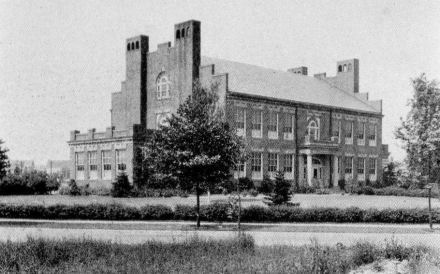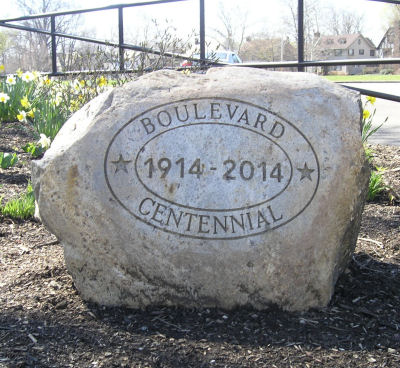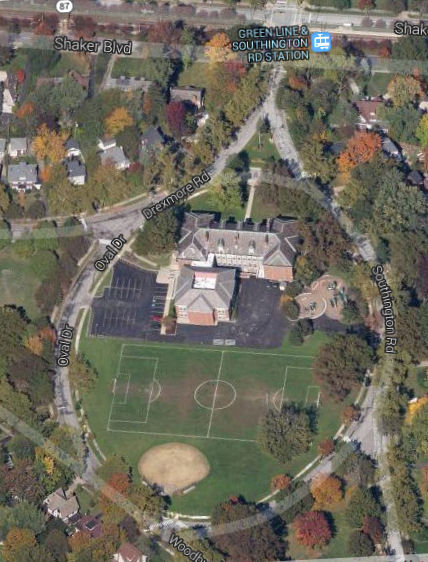 |
 |
|
Above: Boulevard School in 1914 Courtesy of the Shaker Historical Society Right: the boulder, placed in a bed of daffodils, to mark the school's centennial. |
BOULEVARD SCHOOL CELEBRATES ITS CENTENNIAL
|
Shaker Square children can attend the Shaker Heights schools. That's an arrangement that goes back to September 1912 and a swap of school areas between the Boards of Education of the City of Cleveland and Shaker Heights. Until Ludlow Elementary was built in 1928, Boulevard School was the public elementary school for all the Square's children. Today children of Shaker Square families still attend Boulevard School. We salute its century of service. AB |
 |
 |
|
Above: Boulevard School in 1914 Courtesy of the Shaker Historical Society Right: the boulder, placed in a bed of daffodils, to mark the school's centennial. |
|
The school before Boulevard School |
||
|
|
Shaker Village was formed in June 1911 by property owners in the most southern part of Cleveland Heights voting to detach from Cleveland Heights. The Van Sweringen Real Estate sales office on the northeast corner of Shaker Boulevard and Lee Road served as the village's office. Its address was 2889 Lee Road. On October 27, 1911 in a special referendum a small number of Shaker Village voters (one report says only 14) decided to form Shaker Heights Village. They left behind the western end of the Village - from east of the Baldwin Reservoir to East 127th Street - streets of small homes owned by immigrant craftsmen and factory workers. The neighborhoods left behind would soon decide to join Cleveland. The minutes of the Shaker Heights Village Board of Education show the renting of three classrooms in that building. They also tell of hiring two female teachers at $600 annual salary each, plus a male teacher who would also be the principal for $800. About the two photos: |
|
|
|
||
|
1913 - The Plain Dealer reports on the Shaker Heights "Group Plan" |
||||
|
The Real Estate pages of the Sunday Cleveland Plain Dealer of December 12, 1913 reported on the Shaker Heights Group Plan. Probably inspired by Cleveland's famous Group Plan of 1903 by Donald Burnham and others, it proposed a collection of civic buildings south of Boulevard School. That plan never materialized. Shaker Heights Village began with its eastern border just past Horseshoe Lake and its southern border south of South Woodland Boulevard. Soon annexations to the east and to the south would extend those borders. In the larger Shaker Heights the proposed group of buildings was no longer in the center; it was now in the northwest corner. In the 1930's a cluster of civic buildings would be developed near Lee Road and Van Aken Boulevard: a city hall, police station and a library. Why did the description of the school pay so much attention to ventilation? Perhaps because Shaker Heights (and Cleveland Heights as well) emphasized that their elevation meant clean fresh air, an escape from the dust and smoke of the city. Fresh air was a civic value. It was also a time when the idea of the open air school was gaining popularity.
|
|||
|
The 5th and 6th grades, in front of Boulevard School. circa 1915 |
|
|
|
|
|
This is a combined 5th and 6th grade
class. In the back row are the teacher at the left and the school
principal, who also taught a two-grade class, at the right. |
There are more class pictures on the Shaker Historical Society website. They show that by 1920 grades were no longer combined, a sign that enrollment had grown substantially. It would be interesting to learn the students' names and discover more about them. Where did they live? Where did they go after leaving Boulevard School? As Shaker Heights had no high school, the Board of Education would pay tuition to send a child elsewhere. If you are a descendant of one of these students, please contact us. |
|
How the Shaker Heights School District has grown 1914 and now |
||
|
|
||
|
|
Aerial Views 1923 and 2014 |
|
|
|
 |
|
This above aerial view looking north is from Bob Placek via Jeff Buster's blog. link. We date it 1923 because the house due east of the school was built in 1922 and the house (not shown) at the southeast corner of Shaker Blvd. and Southington was built in 1924. How do we know that? The maps on real estate website Zillow.com show addresses. The new website Shaker Building Card Index takes addresses and returns building permit dates and much more. The image at the right is © 2014 Google Maps. |
|
|
Views of the Building |
|
|
|
Learn more on these pages See the 1910 census data for the area that became Shaker Heights link .... How Shaker Village broke away from Cleveland Heights in 1911 link.... How in 1912 the area now called Shaker Square, which is in the City of Cleveland, came into the Shaker Heights Schools link .... The site of the first school and
village hall.
link ..... Learn more on other websites
Shaker Heights Schools website and its
centennial proclamation The Shaker Historical Society's page "Happy Birthday Boulevard School" The Shaker Building Card Index website gives building permit dates and much more. More on open air schools Wikipedia |
| As of May 2, 2014 |